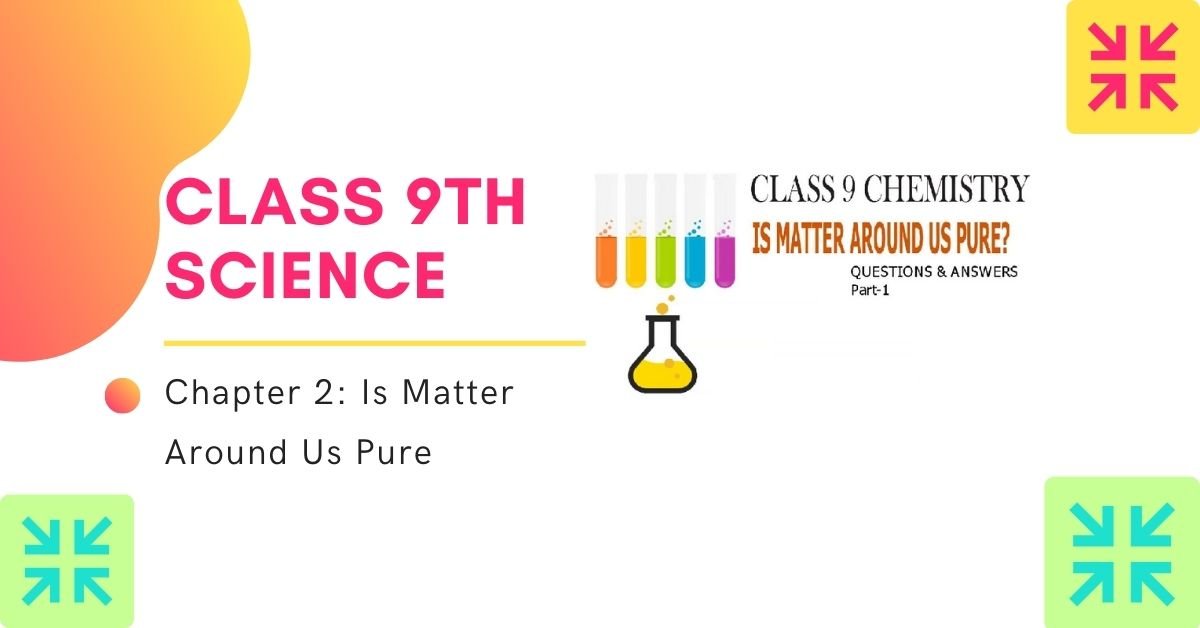www.free-education.in is a platform where you can get pdf notes from 6th to 12th class notes, General Knowledge post, Technical Courses, Engineering post, Career Guidelines , English Speaking Trick , How to crack interview and lots more. (Is matter around us pure notes and NCERT solutions)
We do know that matter is made up of particles which are arranged in a certain way. Gases particles are well separated and can freely move about, solids, on the other hand, have particles that are tightly packed, usually with no scope to move around
- Exercise-2.1 Page: 15
- Exercise-2.2 Page: 18
- Exercise-2.3 Page: 24
- Exercise-2.4 Page: 24
- Exercise Question Page: 28
- Frequently Asked Questions on Chapter 2: Is Matter Around Us Pure
Is Matter Around Us Pure Notes
Pure substances ( Is Matter Around Us Pure )
- Pure substances are elements or compounds.
- They are made up of only one kind of entity.
- They cannot be broken down into simpler entities by chemical or physical methods.
- They have a fixed composition.
- Example: Diamond, carbon dioxide.
Mixtures
- Mixtures are formed by just mixing two or more pure substances (components) such that each substance retains its own chemical identity.

Types of mixtures
1. Homogeneous mixture
A mixture which has a uniform composition throughout is called a homogeneous mixture or solution.
- Examples: sugar in water, salt in water.
2. Heterogeneous mixture
A mixture which contains physically distinct parts and has a non-uniform composition is called a heterogeneous mixture.
- Examples: Mixture of salt and iron filings, sand and sugar.
Physical and chemical changes
- A substance is said to undergo a physical change when only the physical properties such as the shape, size, colour or state of the substance change. No new substance is formed.
- Example: Melting of ice, boiling water.
- A substance is said to undergo a chemical change when a new substance with completely new properties (physical and chemical) is formed.
- Example: Burning of wood or paper, souring of milk.
Solutions:
Solutions and their properties
- A solution is a homogeneous mixture of two or more substances.
Properties:
- Its particles are too tiny and have a diameter less than 1 nm.
- The particles are not visible to naked eyes.
- Particles do not scatter a beam of light passing through it and hence do not show the Tyndall effect.
- The solute particles never settle down on keeping undisturbed.
- The components of a solution cannot be separated using filtration.
Alloys
Alloys are homogeneous mixtures of metals or a mixture of a metal and another element that cannot be separated into their components by physical methods.
Examples:
- Steel, a combination of iron (metal) and carbon (non-metal).
- Bronze, a combination of copper (metal) and tin (metal).
- Brass, a mixture of copper (metal) and zinc (metal).
Concentration of Solutions ( Is Matter Around Us Pure )
Solubility
- Solubility is the property showing the ability of a given substance, which is the solute, to dissolve in a solvent.
- It is measured in terms of the maximum amount of solute dissolved in a solvent at equilibrium.
- The resulting solution is called a saturated solution.
- Factors Affecting Solubility:
- Temperature – Solubility increases with temperature. The situation is different for gases. With the increase in temperature, they became less soluble in each other and in water, but more soluble in organic solvents.
- Pressure – For the majority of solid and liquid solutes, pressure does not affect solubility. The solubility of gas is directly proportional to the pressure of this gas.
Types of solutions based on the concentration of the solution
- Three types of solutions exist based on the concentration of the solution:
- Dilute
- Concentrated
- saturated solution.
Ways of representing the concentration of a solution
The concentration of a solution can be represented in many ways
(i) Mass by the mass percentage of a solution = (Mass of solute / Mass of solution) × 100
(ii) Mass by volume percentage of a solution = (Mass of solute/ volume of solution)×100
Suspensions:-
Suspension and its properties
A suspension is a heterogeneous mixture in which the solute particles do not dissolve but remain suspended throughout the bulk of the medium.
- The solute particles settle down when a suspension is left undisturbed.
- They can be separated from the mixture by filtration.
Colloids ( Is Matter Around Us Pure )
Types of mixtures based on particle size
Classified into:
- Solution
- Suspension.
- Colloidal solution.
Colloidal Solutions
A colloidal solution is a mixture in which the substances are regularly suspended in a fluid.
- Classified into: Foam, Emulsion, Sol
Tyndall Effect
Tyndall effect is the scattering of light by particles in a colloid or else particles in a very fine suspension.
- e.g.It can be observed when sunlight passes through the canopy of a dense forest.
Dispersed phase
The solute-like component of the dispersed particles in a colloid form the dispersed phase.
Dispersion medium
The component in which the dispersed phase is suspended is known as the dispersing medium.
Aerosol
A colloidal solution with dispersed phase solid/liquid and dispersing medium gas is called Aerosol. e.g. clouds
Foam
A colloidal solution with dispersed phase gas and dispersing medium solid/liquid is called Foam. e.g.Shaving cream.
Sols
A colloidal solution with dispersed phase solid and dispersing medium liquid is called Sol. e.g. Milk of magnesia, mud.
Gels and emulsions
- A colloidal solution with dispersed phase liquid and dispersing medium solid is called Gel.
- A colloidal solution with dispersed phase liquid and dispersing medium liquid is called Emulsion.
Evaporation ( Is Matter Around Us Pure )
The process of conversion of water into water vapour is known as evaporation.
- It can be used to separate the volatile component (solvent) from its non-volatile solute.
Introduction to Separation ( Is Matter Around Us Pure )
Separation of components of a mixture
- Heterogeneous mixtures can be separated into their constituents by simple physical methods.
- Methods include: handpicking, sieving, filtration.


Separation of Two Immiscible Liquids ( Is Matter Around Us Pure )
Separation of a mixture of two immiscible liquids
- Separation of a mixture of two immiscible liquids is done by using a separating funnel.
- Applications: To separate a mixture of oil and water, in the extraction of iron from its ore.
Centrifugation
- Centrifugation uses centrifugal force for the separation of two liquids in a mixture.
- Here, a denser component of the mixture migrates away from the axis, and lighter component migrates towards the axis.
Sublimation
Sublimation is the transition of a substance from solid phase to gaseous phase without changing into liquid phase.Example: Naphthalene balls undergo sublimation

Chromatography
- Chromatography is used to separate the different components in a liquid mixture.
- It is based on the different properties of compounds in two phases: stationary and mobile phase.
Distillation
Distillation is a method for separating the component substances from a liquid mixture by selective evaporation and condensation.
- Used in: Production of gasoline, distilled water, xylene, alcohol, paraffin, kerosene etc.
Fractional Distillation
Fractional Distillation is the separation of a mixture into its component parts or fractions by their melting points.
- This is the process of separation of chemical compounds by their boiling point.
- The mixture is heated to a temperature at which one or more fractions will vaporize.
Separation of Air into Its Components ( Is Matter Around Us Pure )
Process of obtaining different gases from the air
Air is a homogeneous mixture and can be separated into its components by fractional distillation.

Crystallization ( Is Matter Around Us Pure )
- Crystallisation is a separation technique in which solids are separated from a solution.
- In this technique, the solvent molecules start evaporating, leaving behind the solutes when the solution is heated in an open container.

Water Purification ( Is Matter Around Us Pure )
Applications of crystallisation
Purification of seawater, separation of alum crystals from impure samples etc.
Elements
- Elements are species of atoms which have the same number of protons in their atomic nuclei.
- Elements are represented by symbols e.g.Hydrogen (H), Boron (B), Carbon (C), Silicon (Si) etc.
Metals
- Metal is a solid material which is typically hard, shiny, malleable, fusible, and ductile, with good electrical and thermal conductivity.
- Examples: Aluminium, Copper, Iron, Tin, Gold
Metalloids
- Metalloids exhibit some properties of metals as well as of non-metals.
- Examples: Boron, silicon, germanium, arsenic, antimony, and tellurium
Compounds
Nonmetals
- Non-metals are brittle and are not malleable or ductile.
- They are poor conductors of heat and electricity.
- Examples: Carbon, Boron etc.
Compounds
Compounds are the substances consisting of two or more different types of elements in a fixed ratio of its atoms.
Difference between mixtures and compounds
- Mixtures are constituted by more than one kind of pure form of matter, known as a substance.
- Types: Homogeneous Mixtures, Heterogeneous Mixtures
- When two or more elements chemically combine in a fixed ratio by mass, the obtained product is known as a compound.
Related link you must like:-
Study material for Competition Exam



